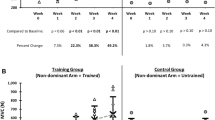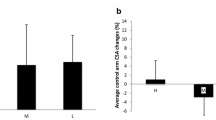Abstract
Purpose
Cross-education of strength has been proposed to be greater when completed by the dominant limb in right handed humans. We investigated whether the direction of cross-education of strength and corticospinal plasticity are different following right or left limb strength training in right-handed participants.
Methods
Changes in strength, muscle thickness and indices of corticospinal plasticity were analyzed in 23 adults who were exposed to 3-weeks of either right-hand strength training (RHT) or left-hand strength training (LHT).
Results
Maximum voluntary wrist extensor strength in both the trained and untrained limb increased, irrespective of which limb was trained, with TMS revealing reduced corticospinal inhibition.
Conclusions
Cross-education of strength was not limited by which limb was trained and reduced corticospinal inhibition was not just confined to the trained limb. Critically, from a behavioral perspective, the magnitude of cross-education was not limited by which limb was trained.






Similar content being viewed by others
Abbreviations
- AMT:
-
Active motor threshold
- CON:
-
Control
- ECR:
-
Extensor carpi radialis muscle
- IHI:
-
Interhemispheric inhibition
- LHT:
-
Left hand training
- MEP:
-
Motor-evoked potential
- M MAX :
-
Maximum compound action potential
- M1:
-
Primary Motor cortex
- MVIC:
-
Maximum voluntary isometric contraction
- 1RM:
-
One-repetition maximum
- RHT:
-
Right hand training
- rmsEMG:
-
Root mean square electromyography
- sEMG:
-
Surface electromyography
- SICI:
-
Short-interval intracortical inhibition
- TMS:
-
Transcranial magnetic stimulation
References
Amuntsa K, Schlaugb G, Schleichera A, Steinmetzb H, Dabringhausa A, Rolandc PE, Zillesa K (1996) Asymmetry in the human motor cortex and handedness. NeuroImage 4:216–222
Ackerly SJ, Stinear CM, Byblow WD (2011) Promoting use-dependent plasticity with externally-paced training. Clin Neurophysiol 122:2462–2468
Brown AB, McCartney N, Sale DG (1990) Positive adaptations to weight-lifting training in the elderly. J Appl Physiol 69:1725–1733
Calancie B, Nordin M, Wallin U, Hagbarth KE (1987) Motor-unit responses in human wrist flexor and extensor muscles to transcranial cortical stimuli. J Neurophysiol 58:1168–1185
Carroll TJ, Herbert RD, Munn J, Lee M, Gandevia SC (2006) Contralateral effects of unilateral strength training: evidence and possible mechanisms. J Appl Physiol 101:1514–1522
Christie A, Kamen G (2014) Cortical inhibition is reduced following short-term training in young and older adults. Age 36:749–758
Criscimagna-Hemminger SE, Donchin O, Gazzaniga MS, Shadmehr R (2003) Learned dynamics of reaching movements generalize from dominant to nondominant arm. J Neurophysiol 89:168–176
Dragert K, Zehr P (2013) High-intensity unilateral dorsiflexor resistance training results in bilateral neuromuscular plasticity after stroke. Exp Br Res 225:93–104
Farthing JP (2009) Cross-education of strength depends on limb dominance: implications for theory and application. Exerc Sport Sci Rev 37:179–187
Farthing JP, Zehr EP (2014) Restoring symmetry: clinical applications of cross-education. Exerc Sport Sci Rev 42:70–75
Farthing JP, Chilibeck PD, Binsted G (2005) Cross-education of arm muscular strength is unidirectional in right-handed individuals. Med Sci Sports Exerc 37:1594–1600
Farthing JP, Borowsky R, Chilibeck P, Binsted G, Sarty G (2007) Neuro-physiological adaptations associated with cross-education of strength. Brain Topogr 20:77–88
Farthing JP, Krentz JR, Magnus CRA, Barss TS, Lanovaz JL, Cummine J et al (2011) Changes in functional magnetic resonance imaging cortical activation with cross education to an immobilized limb. Med Sci Sport Exerc 43:1394–1405
Fimland M, Helgerud J, Solstad GM, Iversen VM, Leivseth G, Hoff J (2009) Neural adaptations underlying cross-education after unilateral strength training. Eur J Appl Physiol 107:723–730
Goodwill AM, Pearce AJ, Kidgell DJ (2012) Corticomotor plasticity following unilateral strength training. Muscle Nerve 46:384–393
Hammond G (2002) Correlates of human handedness in primary motor cortex: a review and hypothesis. Neurosci Biobehav Rev 26:285–292
Hendy AM, Kidgell DJ (2013) Anodal tDCS applied during strength training enhances motor cortical plasticity. Med Sci Sports Exerc 45:1721–1729
Hinder MR, Carroll TJ, Summers JJ (2013) Inter-limb transfer of ballistic motor skill following non-dominant limb training in young and older adults. Exp Brain Res 227:19–29
Hopler L, Biallas M, Wolf M (2009) Task complexity relates to activation of cortical motor areas during uni- and bimanual performance: a functional NIRS study. Neuroimage 46:1105–1113
Hortobagyi T, Lambert NJ, Hill JP (1997) Greater cross education following training with muscle lengthening than shortening. Med Sci Sports Exerc 29:107–112
Hortobagyi T, Richardson SP, Lomarev M, Shamim E, Meunier S, Russman H, Dang N, Hallett M (2011) Interhemispheric plasticity in humans. Med Sci Sports Exerc 43:1188–1199
Howatson G, Taylor MB, Rider P, Motawar BR, McNally MP, Solnik S, DeVita P, Hortobágyi T (2011) Ipsilateral motor cortical responses to TMS during lengthening and shortening of the contralateral wrist flexors. Eur J Neurosci 33:978–990
Kidgell DJ, Stokes MA, Perace AJ (2011) Strength training of one limb increases corticomotor excitability projecting to the contralateral homologous limb. Motor Control 15:247–266
Kidgell DJ, Frazer AK, Daly RM, Rantailanen T, Ruotsalainen I, Ahtiainen J, Avela J, Howatson G (2015) Increased cross-education of muscle strength and reduced corticospinal inhibition following eccentric strength training. Neuroscience 300:566–575
Lagerquist O, Zehr EP, Docherty D (2006) Increased spinal reflex excitability is not associated with neural plasticity underlying the cross-education effect. J Appl Physiol 100:83–90
Lee M, Gandevia SC, Carroll TJ (2009) Unilateral strength training increases voluntary activation of the opposite untrained limb. Clin Neurophysiol 120:802–808
Lee M, Hinder MR, Gandevia SC, Carroll TJ (2010) The ipsilateral motor cortex contributes to cross-limb transfer of performance gains after ballistic motor practice. J Physiol 588:201–212
Leung M, Rantalainen T, Teo WP, Kidgell DJ (2015) Motor cortex excitability is not differentially modulated following skill and strength training. Neuroscience 305:99–108
Magnus CRA, Barss TS, Lanovaz JL, Farthing JP (2010) Effects of cross-education on the muscle after a period of unilateral limb immobilization using a shoulder sling and swathe. J Appl Physiol 109:1887–1894
Magnus CRA, Arnold CM, Johnston G, Haas VD, Basran J, Krentz JR, Farthing JP (2013) Cross-education for improving strength and mobility following distal radius fractures: a preliminary randomized controlled trial. Arch Phys Med Rehabil 94:1247–1255
Munn J, Herbert RD, Hancock MJ, Gandevia SC (2005) Resistance training for strength: effect of number of sets and contraction speed. Med Sci Sports Exerc 37:1622–1626
Pearce AJ, Hendy AM, Bowen WA, Kidgell DJ (2012) Corticospinal adaptations and strength maintenance in the immobilized arm following 3 weeks unilateral strength training. Scan J Med Sci Sports 23:740–748
Perez MA, Cohen LG (2008) Mechanisms underlying functional changes in the primary motor cortex ipsilateral to an active hand. J Neurosci 28:5631–5640
Ruddy KL, Carson RG (2013) Neural pathways mediating cross education of motor function. Front Hum Neurosci 7:397
Selvanayagam VC, Riek S, Carroll TJ (2012) A systematic method to quantify the presence of cross-talk in stimulus-evoked EMG responses: implications for TMS studies. J Appl Physiol 112:259–265
Thaut MH, Kenyon GP, Hurt CP, McIntosh GC, Hoemberg V (2002) Kinematic optimization of spatiotemporal patterns in paretic arm training with stroke patients. Neuropsychology 40:1073–1081
Watanabe M, Maemura K, Kanbara K, Tamayama T, Hayasaki H (2002) GABA and GABA receptors in the central nervous system and other organs. Int Rev Cytol 213:1–47
Zijdewind I, Butler JE, Gandevia SC, Taylor JL (2006) The origin of activity in the biceps brachii muscle during voluntary contractions of the contralateral elbow flexor muscles. Exp Brain Res 175:526–535
Zult T, Howatson G, Kádár EE, Farthing JP, Hortobágyi T (2014) Role of the mirror-neuron system in cross-education. Sport Med 44:159–178
Acknowledgments
Many thanks to all the participants for giving their time to partake in this research project.
Author information
Authors and Affiliations
Corresponding author
Ethics declarations
Conflict of interest
The authors declare no conflict of interest.
Additional information
Communicated by Toshio Moritani.
Rights and permissions
About this article
Cite this article
Coombs, T.A., Frazer, A.K., Horvath, D.M. et al. Cross-education of wrist extensor strength is not influenced by non-dominant training in right-handers. Eur J Appl Physiol 116, 1757–1769 (2016). https://doi.org/10.1007/s00421-016-3436-5
Received:
Accepted:
Published:
Issue Date:
DOI: https://doi.org/10.1007/s00421-016-3436-5




